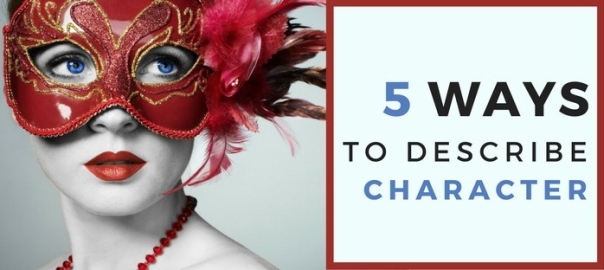How do you describe your characters?
Here’s an amazing writing trick:
Go to the mirror, write what you see, and…
…never, ever do that again.
Because describing your characters with a checklist is BORING:
- Her eyes were brown
- And her hair was brown
- Even her teeth were brown
- She really should brush more often
If you want to describe the physical appearance of your characters, go see how J. K. Rowling does it.
Otherwise, keep reading. I’ll show you how to make your characters come to life…
…without writing dull, immersion-breaking, “this is how they look” paragraphs:
Are Physical Descriptions “Unnecessary?”
As a writer, the reader’s imagination is your most powerful tool.
Whether you’re writing horror, or awesome fantasy, you want to make your readers do the work for you.
Who is more interesting to visualize?
- Joan who had short blond hair, wiry arms, and blue eyes.
- Joan, the only woman who could swing a Broadsword… better than most of the men.
When you can show your characters – without explicitly telling readers what they look like – will make your characters feel more organic, and will keep your readers immersed in your story.
#1 – How Do They Act?
There are hundreds of ways to use actions to describe your characters.
The secret?
Make the action unique. Force your readers to imagine someone performing the action.
How they Act Towards Themselves
A few actions from Stephen King’s The Shining:
- “[Jack] rubbed his hand harshly across his lips and followed Watson into the boiler room.”
- “He wiped his lips with the palm of his hand.”
- “He pulled his handkerchief from his back pocket, wiped his mouth with it, and walked over.”
Early in the novel, Stephen King tied this action to an extremely harsh memory: Jack breaking his son’s arm in a fit of rage.
It’s something that Jack seems to regret, but we’re not sure how much he regrets it.
So every time Jack wipes his lips, King accomplishes a few things:
- Builds distrust
- Shows Jack’s struggle with alcoholism
- Gives us a greasy – even hateful – image of the character
No matter how you picture Jack, every time you watch him wipe his lips, your visual image of him becomes a little darker, a little more frayed around the edges.
By showing us unsavory actions, we create a mental image of an unsavory character – without expressly saying “he had long greasy hair, and anger in his eyes.”
How They Act Towards Others
Another example, from a great fantasy novel called Uprooted.
Our heroine, Agnieszka, is training under the local Wizard, but she can’t seem to get anything right:
He roared at me furiously for ten minutes after he finally managed to put out the sulky and determined fire, calling me a witless muttonheaded spawn of pig farmers — “My father’s a woodcutter,” I said — “Of axe-swinging lummocks!” he snarled. But even so, I wasn’t afraid anymore. He only spluttered himself into exhaustion and then sent me away, and I didn’t mind his shouting at all, now I knew there were no teeth in it to rend me.
What kind of Wizard did you see?
We understand he’s powerful, and has incredibly high standards…
…but most of all, we realize that he has more smoke than fire.
By showing us this character trait, instead of talking about his physical stature, this scene paints a much more vivid image of the Wizard.
He’s not just a towering, loud-mouthed, tyrant. He’s a tyrant who doesn’t bite – which is far more intriguing.

#2 – Where Are They? Where Do They Come From?
What if, instead of describing what you see in the mirror, you described the mirror itself?
- Shattered?
- Framed in a lavish gold leaf?
- Covered in dust, and ancient grime?
Each mirror will portray an entirely different person – without actually describing the person.
Your tone, your atmosphere, and your setting will play a major role in how people view your characters.
For example, imagine Harry Potter at Hogwarts…
…and Harry Potter in a grim, post-apocalyptic wasteland swarming with bands of cannibals. Do they look different?

How Can Setting Describe a Character?
Borne, by Jeff VanderMeer, does an excellent job of building the setting into the character:
Borne is a genetically-modified lifeform, whose very nature defies physical description.
Why?
Because his body is constantly morphing.
There are sections where the author attempts to describe Borne. But you get the most powerful images when the narrator describes the world that Borne inhabits.
Here, our narrator talks about when she first found Borne and talks about what he reminds her of:
Instead, for a dangerous moment, this thing I’d found was from the tidal pools of my youth, before I’d come to the city. I could smell the pressed-flower twist of the salt and feel the wind, knew the chill of the water rippling over my feet. The long hunt for seashells, the gruff sound of my father’s voice, the upward lilt of my mother’s. The honey warmth of the sand engulfing my feet as I looked toward the horizon and the white sails of ships that told of visitors from beyond our island.
But the description doesn’t stop there.
As more of this strange, ruined world is revealed to us – in all of its fecund, overgrown, and irradiated glory – Borne unfurls and grows and changes, too.
You move through settings that are playful, beautiful, and filled with threats too dangerous to ignore. Which is a perfect description of Borne.
The most powerful anchors of Borne’s physical description come from the moments where we see his birth place at “the Company.”
We see the magnificent and often-incomprehensible wonders in that place. And with each new wonder, we are reminded that this is Borne’s origin, and what his creators had in mind.
So when we try to envision Borne, we can’t help but see all the strange atrocities, and well-meaning attempts at scientific discovery… gone horribly wrong.
#3 – What Does Your Character Do?
Here are two completely different images:
- Theoretical Physicist
- Blacksmith’s apprentice
Professions are one of the quickest ways to describe characters – especially if they’re a minor character.
From George R. R. Martin’s new novel, The Winds of Winter:
They had no trouble buying horses, though the cost was five times what it would have been last year.
“They’re old, but sound,” claimed the hostler. “you’ll not find better this side of Storm’s End. The griffin’s men seize every horse and mule they come upon. Oxen too. Some will make a mark upon a paper if you ask for payment, but there’s others who would just as soon cut your belly open and pay you with a handful of your own guts. If you come on any such, mind your tongues and give the horses up.”
This character is so minor, he doesn’t need any physical description. A quick mention of what he is sufficiently conjures up an image of the character.
What About Major Characters?
In Patrick Rothfuss’s The Name of the Wind, the protagonist says that he was once part of a traveling Troupe of actors.
We also come to find that he is a talented musician and plays the Lute.
With those two professions in mind, how do you view this character?
I see his fingers, his arms, and the way he moves:
- thin, almost reedy
- but moves gracefully across his stage
- he has delicate fingers that strum with a rhythmic certainty known only to the musically inclined
When you’re dealing with a major character, it’s important for you to dig into their profession.
Talk about what they’re good at, where they struggle, or what makes them unique.
So, if George R. R. Martin wanted to develop his hostler into a major character, he might talk about how the hostler is…
- Terrified of horses (unless they have spots)
or…
- The only hostler who can calm down wild stallions
or…
- Cruel. Never gives them enough feed, and always hits them too hard.
These kinds of conflicts or traits bring the character a richer, more meaningful existence.
#4 – Make Other Characters React (or Talk about) Them
I read a very unique Science Fiction book recently by Nnedi Okorafor.
Binti is about the cultural differences have made their way into the future.
The main character (Binti) hails from a specific place in Africa, where the ground is red, and the people “bring it with them” by braiding it into their hair, and covering their skin with it. They call it otjize.
Binti is headed to a University (where cultures collide). She’s the first of her people to attend, and it sets her apart immediately:
Just before leaving, I’d rolled my plaited hair with fresh sweet-smelling otjize I’d made specifically for this trip. Who knew what I looked like to these people who didn’t know my people so well.
A woman leaned away from me as I passed, her face pinched as if she smelled something foul. “Sorry,” I whispered, watching my feet and trying to ignore the stares of almost everyone in the shuttle. Still, I couldn’t help glancing around. Two girls who might have been a few years older than me, covered their mouths with hands so pale that they looked untouched by the sun. Everyone looked as if the sun was his or her enemy. I was the only Himba on the shuttle.
How other characters talk about – or react to – your character will make a huge difference in how readers perceive that character.
This passage sets off how “out of place” Binti must feel because of her appearance.
If, instead, the girls had ignored Binti, or hadn’t noticed Binti at all, we would have a completely different impression of her.
What if one of them had seen her, and screamed? What if one of them fell in love with her on the spot?

#5 – What Does it Have in its Pocketses? (Or its Hands?)
Want to surprise your readers?
Give your character something incongruous about their appearance. It could be something they’re wearing, something about their hair, or what they have in their hands.
Take a look at Gandalf from Tolkien’s The Fellowship of the Ring:
An old man was driving it all alone. He wore a tall pointed blue hat, a long grey cloak, and a silver scarf. He had a long white beard and bushy eyebrows that stuck out beyond the brim of his hat.
You have this stereotypical image of a wizened wizard. Not much in the way of personality, until…
Small hobbit-children ran after the cart all through Hobbiton and right up the hill. It had a cargo of fireworks, as they rightly guessed.
Because Gandalf is hauling a cartload of fireworks, you can almost see that mischievous grin, that twinkle in his eyes – even though it’s not stated in this paragraph.
You know this is not an ordinary wizard, and that immediately changes your mental image of him.

Every Line in Your Story Should Accomplish Something
Whether you’re setting the tone, or building the world, every sentence should pull its weight.
Really good writers can make their sentences do double, or triple, duty:
- push the plot
- set the scene/tone
- develop the theme
- develop your characters
With these 5 tools, you should have a much, much easier time developing your characters.
They will come to life – and you will love writing about them.





Excellent post. I groan when I read flat character descriptions down to the tan khaki slacks. Ugh. These are great tips and the examples are helpful in demonstrating the points. Well done.
LikeLiked by 1 person
Good and thoughtful points, Mr. Hoffman!
LikeLiked by 1 person
Those are surprisingly kind words from someone called Grouchy =)
LikeLike
I’ve always found novels with characters who don’t have too much physical description much easier to follow along. What I find worse is when the character is given physical description later in the book. It’s so annoying reading 80% of something with a clear depiction of a character only for the author to add a physical description and completely disrupt my focus on the story.
I also largely agree with #3 because it helps focus on the characters that actually matter. I don’t particularly enjoy hindering immersion by constantly asking, “oh is she that one person who did X or was she the one who did Y?”
#5 reminds of Vonnegut’s writing style which I certainly agree with.
Great article as always 🙂
LikeLiked by 1 person
To the 80% thing – YES. If you’re going to make description important, make it important EARLY. Thanks T.
LikeLiked by 1 person
I’m particularly fond of #3 and #5. In some ways #5 feels like an extension or cousin to #3, since many professionals carry the tools/resources of their trade(s) with them. Kovothe often has his lute, just as Gandalf often has his staff. Granted, a good story needs to be open to all possibilities, but professions and skills often represent a long term investment, and really say something about a character. Just the fact that someone chooses something, and chooses to dedicate years to learning and mastering it, says so much about who they are.
LikeLike